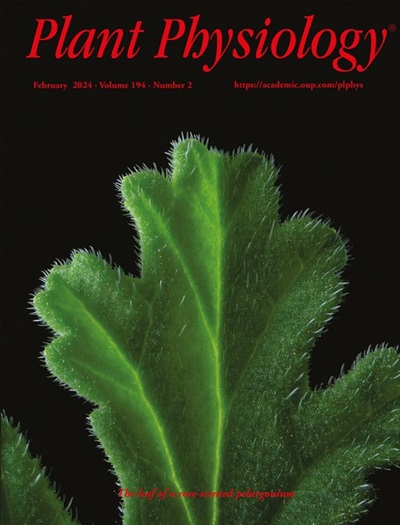Potato β-aminobutyric acid receptor IBI1 manipulates VOZ1 and VOZ2 transcription factor activity to promote disease resistance
IF 6.5
1区 生物学
Q1 PLANT SCIENCES
引用次数: 0
Abstract
Upon infection with non-pathogenic microorganisms or treatment with natural or synthetic compounds, plants exhibit a more rapid and potent response to both biotic and abiotic stresses. However, the molecular mechanisms behind this phenomenon, known as defense priming, are poorly understood. β-aminobutyric acid (BABA) is an endogenous stress metabolite that enhances plant tolerance to various abiotic stresses and primes plant defense responses, providing the ability to resist a variety of pathogens (broad-spectrum resistance). In this study, we identified an aspartyl-tRNA synthetase (AspRS), StIBI1 (named after Arabidopsis IMPAIRED IN BABA-INDUCED IMMUNITY 1; IBI1), as a BABA receptor in Solanum tuberosum. We elucidated the regulatory mechanisms by which StIBI1 interacts with two NAC (NAM, ATAF1, 2, and CUC2) transcription factors (TFs), StVOZ1 and StVOZ2 (VASCULAR PLANT ONE ZINC FINGER, VOZ), to activate BABA-induced resistance (BABA-IR). StVOZ1 represses, whereas StVOZ2 promotes, immunity to the late blight pathogen Phytophthora infestans. Interestingly, BABA and StIBI1 influence StVOZ1- and StVOZ2-mediated immunity. StIBI1 interacts with StVOZ1 and StVOZ2 in the cytoplasm, reducing the nuclear accumulation of StVOZ1 and promoting the nuclear accumulation of StVOZ2. Our findings indicate that StVOZ1 and StVOZ2 finely regulate potato resistance to late blight through distinct signaling pathways. In summary, our study provides insights into the interaction between the potato BABA receptor StIBI1 and the TFs StVOZ1 and StVOZ2, which affects StVOZ1 and StVOZ2stability and nuclear accumulation to regulate late blight resistance during BABA-IR. This research advances our understanding of the primary mechanisms of BABA-IR in potato and contributes to a theoretical basis for the prevention and control of potato late blight using BABA-IR.马铃薯β-氨基丁酸受体IBI1操纵VOZ1和VOZ2转录因子的活性以促进抗病性
在感染非病原微生物或受到天然或合成化合物处理后,植物会对生物和非生物胁迫做出更迅速、更有力的反应。然而,人们对这种被称为 "防御启动 "的现象背后的分子机制知之甚少。β-氨基丁酸(BABA)是一种内源胁迫代谢产物,可增强植物对各种非生物胁迫的耐受性,并激发植物的防御反应,从而提供抵抗各种病原体的能力(广谱抗性)。在这项研究中,我们发现天冬氨酰-tRNA 合成酶(AspRS)StIBI1(以拟南芥 IMPAIRED IN BABA-INDUCED IMMUNITY 1;IBI1 命名)是 Solanum tuberosum 中的 BABA 受体。我们阐明了 StIBI1 与两个 NAC(NAM、ATAF1、2 和 CUC2)转录因子(TF)StVOZ1 和 StVOZ2(VASCULAR PLANT ONE ZINC FINGER,VOZ)相互作用激活 BABA 诱导的抗性(BABA-IR)的调控机制。StVOZ1 抑制而 StVOZ2 促进对晚疫病病原体 Phytophthora infestans 的免疫。有趣的是,BABA 和 StIBI1 会影响 StVOZ1- 和 StVOZ2- 介导的免疫力。StIBI1 与细胞质中的 StVOZ1 和 StVOZ2 相互作用,减少了 StVOZ1 的核积累,促进了 StVOZ2 的核积累。我们的研究结果表明,StVOZ1 和 StVOZ2 通过不同的信号途径精细调节马铃薯对晚疫病的抗性。总之,我们的研究深入揭示了马铃薯BABA受体StIBI1与TFs StVOZ1和StVOZ2之间的相互作用,这种相互作用影响StVOZ1和StVOZ2的稳定性和核积累,从而在BABA-IR过程中调控马铃薯对晚疫病的抗性。该研究加深了我们对 BABA-IR 在马铃薯中的主要作用机制的理解,为利用 BABA-IR 防治马铃薯晚疫病提供了理论依据。
本文章由计算机程序翻译,如有差异,请以英文原文为准。
求助全文
约1分钟内获得全文
求助全文
来源期刊

Plant Physiology
生物-植物科学
CiteScore
12.20
自引率
5.40%
发文量
535
审稿时长
2.3 months
期刊介绍:
Plant Physiology® is a distinguished and highly respected journal with a rich history dating back to its establishment in 1926. It stands as a leading international publication in the field of plant biology, covering a comprehensive range of topics from the molecular and structural aspects of plant life to systems biology and ecophysiology. Recognized as the most highly cited journal in plant sciences, Plant Physiology® is a testament to its commitment to excellence and the dissemination of groundbreaking research.
As the official publication of the American Society of Plant Biologists, Plant Physiology® upholds rigorous peer-review standards, ensuring that the scientific community receives the highest quality research. The journal releases 12 issues annually, providing a steady stream of new findings and insights to its readership.
 求助内容:
求助内容: 应助结果提醒方式:
应助结果提醒方式:


